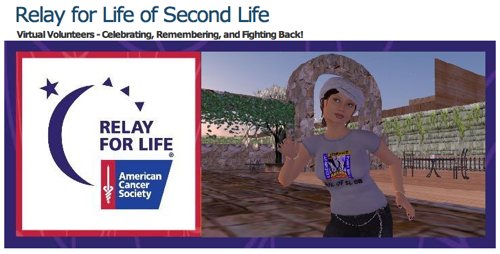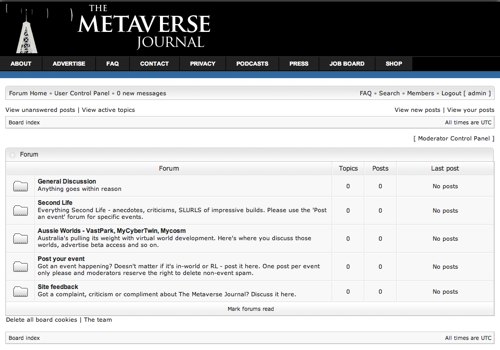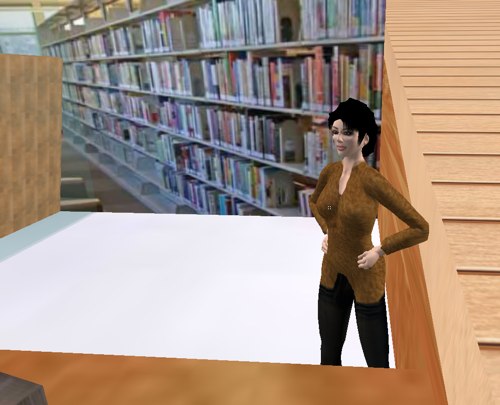We started our weekly does of virtual world machinima called Weekend Whimsy
The first featured video:
The Cecil Codex Chapter 5
Tech -- Culture -- Humour
We started our weekly does of virtual world machinima called Weekend Whimsy
The first featured video:
The Cecil Codex Chapter 5
Got a hankering to write a scholarly article on an ethics and virtual worlds-related issue?
Then check this out. There’s nothing like a book credit on your CV.
I spend hours with my computer. It is my favorite tool. I spend time in and out of virtual worlds; I spend time on and off the Internet, surfing with my browser. I communicate, I work, I play. From the sheer amount of time spent with my machine during the day, according to some measures, it would be correct to say that I am addicted to the behaviour of using my computer. I do not, however, consider this to be an addiction.
Several people within my experience also spend a great deal of time with their computers. Interestingly, the particular people I am thinking of were also at one time thought to be drug addicts. Each of these people suffers from either a physical pain disorder, or from a chemical mental disorder. The drugs they take assist their functioning, above and beyond the side effects they cause. I do not consider any of these people to be addicts, either, with regards to drug use or computer use.
Why is this not addiction?
The most important signs of addiction, and indeed the ones that cry out for treatment, are loss of control regarding the addiction and destructive behaviors of and surrounding the addiction. Neither I nor my friends exhibit these signs in our computer usage nor drug usage; therefore, this behavior is not an addiction, by definition.
Why does it look like addiction?
One of the primary signs attributed to addictions of computer usage is time spent engaging in the behavior. This sign may help with the diagnosis of an addiction, but alone cannot be used to make the diagnosis.
Consider how many hours a day the average person spends at work. Perhaps eight hours all up, divided into an hour for lunch, a couple of hours for meetings and other communications, and the rest for the actual work they do. Then consider that person gets home (two hours for travel), eats (two hours for eating at home), and watches TV or reads (four hours). This accounts for sixteen hours of the day, roughly.
Imagine, then, if all of this could be accomplished from their computer at home. Suddenly, rather than seeing a person spending sixteen hours a day in mindless clicking, there is someone working, communicating, gathering news and information and finding entertainment using the same tool.
Another sign often taken alone and out of context is a lack of face-to-face communication on behalf of a person who uses computers.
There are many different scenarios in which face-to-face communication is not applicable, but for example, consider a person with a physical disability in which face-to-face communication is difficult to achieve. For someone with limited mobility or large amounts of pain, getting out of the house may range from impractical to impossible. Consider sufferers of social anxieties, or autistic folk, who are barely able to communicate face-to-face, but whom are liberated by the digital space.
Is quality of life being gained or lost?
Where there is a gain in quality of life which exceeds the downsides to the behavior, there is unlikely to be an addictive problem. With drugs for pain relief, it has been found that it’s very rare for folks who require the drug for pain relief to exhibit loss of control or destructive behaviors concerning the drug, even though they have a physical dependence on it. There may be withdrawal symptoms and side effects, but overall the quality of life increase for these folks. Being able to take care of themselves, their homes, their families, and having enjoyment in life far outweighs the problems in most cases.
Technology is enabling.
Can you imagine telling someone with no legs to forsake their wheelchair? How about someone with a pain disorder? Are you going to tell people with crippling mental disorders that they are not allowed to take drugs to normalize and enable them? Are you going to tell deaf people they can’t use Teletype in place of the telephone?
Each of these technological advances were radical in their time; some of them were seen as being destructive, to society or to the individual. It’s hard to imagine any of these people being denied their enabling technologies in today’s first world society (one hopes). I hope to live in a future where my enabling computer habits are accepted.
What harm is being done, to whom, if I take care of myself, my family, my house, my dog, my finances and my business, while still spending many hours a day at my desk at home?
1. Emirates Business 24/7 (UAE) – Why your Second Life is more than Lively. “Virtual history has a habit of repeating itself. Not so long ago, hype surrounding the ‘Second Life’ 3D world seized gamers and companies alike. Now the limelight is on Google’s similar offering, Lively. Google’s virtual world was launched less than a fortnight ago, yet already there are scores of reviews and blogs about it. Very few are from the UAE, where the site appears to have been blocked by the local authorities.”
2. Newsweek (USA) – Living a Second Life Online. “We’ve all heard the warnings: addiction, isolation, a waste of time. But some 50 million people log on to online role-playing games like The Sims and Second Life—and many of them never log off. The makers of a new documentary called “Second Skin,” which hits theaters in September, followed seven hard-core gamers to find out why.”
3. GigaOM (USA) – Will Mark Kingdon’s Reign Boost Second Life? “Back in April, ex-Organic CEO Mark Kingdon took the helm of Linden Lab, replacing its charismatic founder, Philip Rosedale, at a time when the company was already struggling in an increasingly competitive market. While Linden claims to be profitable, its market share has plateaued, with scalability and usability woes keeping the number of monthly active users around 550,000 since last summer. Is Second Life still relevant in this far more dynamic playing field, which now includes Lively, an offering from the Internet’s biggest player? I posed that question to Kingdon a few days ago in an extended conversation at the company’s spacious San Francisco headquarters.”
4. TechNewsWorld (USA) – Second Life: A Wide World for Med, Science Students. “Judith Kung Fu may be just one of more than 14 million computer-generated characters in the 3-D virtual world Second Life. But with her help, her creator may one day save your life. In Second Life, Judith has walked through the walls of a human cell. She has, in a flash, conducted complicated science experiments that took the world’s best minds years to complete.”
5. DMNews (USA) – Social strategy is in this fall. “For their back-to-school efforts, a number of multichannel merchants are marrying micro sites with a significant push into social networking. Some marketers see tie-ins with social networking sites, including MySpace and Facebook, as the biggest opportunity to reach teen agers. But it is uncertain whether these efforts will be enough to ignite teen retail spending, which industry experts predict will be down for the rest of the year.”
6. The Industry Standard (USA) – Google trying to stop the inevitable: Cyber-sex in Lively. “Google’s biggest mistake with Lively may not be the Windows-only release, nor the sketchy functionality. Instead, it’s in forgetting (or ignoring) the driving force of the Internet, which, as the Broadway musical Avenue Q explains, is porn. Google introduced Lively as an all-ages 3D chat application. But, as The Guardian noted a mere day after Lively launched, users quickly figured out how to take things as far as they could with adult content. Google tries to police the adult content as much as possible, but a search will quickly yield scores of rooms designed for cybersex of all kinds.”
7. Mediashift Idea Lab (USA) – Virtual Voting: Finding Our Audience Where They Roam. “A Street Team ’08 video by our Connecticut reporter plays at Election HQ in MTV’s Virtual World. One of the main components of Knight and MTV’s big citizen journalism experiment, Street Team ’08, is MOBILE. In our case, the already loaded term has many meanings…our project includes mobile phones, on both the production and distribution sides, and mobile journalists, or those young, carefree reporters-on-the-go with no need for an office, who you keep hearing about.”
8. The Hollywood Reporter – ‘L Word’ virtual world in works. “Showtime has inked a deal with virtual world technology company The Electric Sheep Company to create a standalone Web-based virtual world for drama series “The L Word.” The L Word virtual world, which begins testing next month and formally launches with the debut of the series’ new season in early 2009, will be the first to use Electric Sheep’s new WebFlock, a Flash-based solution that eliminates the lengthy downloads and other technological barriers that have prevented some virtual worlds from attracting the mass market.”
9. The London Free Press (Canada) – A big thumbs up. All three game console makers are officially on the avatar bandwagon, with Microsoft’s revelation that gamers will soon be able to create and customize virtual versions of themselves to mingle online and play games. Microsoft seems to be aiming for something in between Nintendo’s cutesy Mii avatars and Sony’s more realistic and functional Home, which we won’t see until next year. One intriguing aspect of Xbox’s so-called Live Party system is the ability to get together online with friends to share photos, play virtual game shows or even watch movies. It’ll be intriguing to see how (or if) this works when the Xbox Live update hits later this year.”
10. Silicon Valley Insider (USA) – Google’s Lively Is Just Like Second Life — No One’s There But Perverts And Griefers. “We’ve all heard the knock on marketing in Second Life — brands that do it get a splash of PR, but little else. Most brands end up with abandoned virtual storefronts and negative ROI. So last week, when Google (GOOG) introduced “Lively,” its own virtual worlds product we had hopes that it might suceeed where Linden Lab (SAI 25: #11) failed.”
Am I the only one that experiences nausea at the thought of Microsoft integrating its technologies with the OpenSim virtual world platform?
To me, any technology that’s brand-specific is going to cause more problems than deliver solutions when the longer term view is taken for interoperability.
Second Life’s Relay for Life is well underway – it’s hard to believe it’s been a year since the last one.

Check the schedule and get involved if you can.
When we first launched in late 2006 we also had forums, which were moderately utilised on those first months, particularly by the ABC prior to the launch of ABC Island. We closed the forums down mid-2007 due to lack of activity and some technical problems with the platform we were using.
I’m really pleased to re-launch the forums which can be found here or via the ‘Forum’ link at the top of this site. The focus is widened and the actual design fits better with the overall site.

On the downside, due to a database corruption I wasn’t able to import all the previous posts into the new forum – it’s literally a blank slate so if you’d previously registered, you’ll need to do so again. Sorry!
If you’ve got a point to make, an event to promote or just want to mix with other virtual world residents, please use the forums – that’s what they’re there for.
To celebrate the relaunch, we’re offering 5000 Linden Dollars to a lucky someone who posts on the forums by the end of August 2008. We’ll get a random number generator to give us a number – the person who posted that number post will be the winner. Example: if the random number was 77 – the person who posted the 77th post wins the prize.
So jump in, start a discussion and maybe you’ll be rewarded for your efforts beyond the rewards of forum interaction 😉
New World Notes’ Wagner James Au was checking out the new Daden in-world web browser when he had a couple of interesting interactions with a ‘robotar’ although his pick-up lines left a little to be desired.

I spent some time with ‘Abi’ myself and agree that for a bot she’s relatively engaging if you’re happy to talk about Daden products. There are other impressive bots out there but as you’ll see from the snippet below, Abi is single, something the above correspondent wasn’t able to determine 😉
You: chatbot?
abi: It is feasible to run an avatar chatbot over a GPRS or dial-up GSM link, but not advisable. For this reason we suggest making a textbot available for mobile users. Avatars should run OK over 3G networks.
abi: Talk to me!
You: why?
abi: Sorry, I didn’t understand. I can tell you about Daden and our products and services, virtual worlds and chatbots.
You: are you married?
abi: Not the last time I looked.
I’d love to hear what your most amusing bot experiences are, whether they be in Second Life, World of Warcraft or elsewhere…
1. Gibson Island on Second Life
2. Madonna Give It To Me (Second Life Version)
3. Second Life Avatar Vignette
Lifenaut is a fascinating service that allows you to create an interactive avatar based on the information you provide. Getting the information into your profile involves an extensive web-based dashboard set-up that you could easily spend hours configuring. At the end of it you’ve created a ‘mindfile’ that drives your avatar’s behaviour.

Aside from the avatar-based approach of Lifenaut, a further virtual world hook is the recent introduction to Lifenaut that occurred in Second Life at their New User Center. A ‘universal avatar’ is something desirable in some people’s eyes and services like Lifenaut will attract some interest if they manage to keep in sync with interoperability developments in virtual worlds.
Copyright © 2024 · Magazine Child Theme on Genesis Framework · WordPress · Log in
Recent Comments